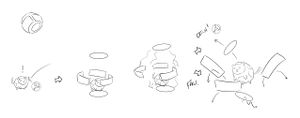Capturing
When the player faces a wild tuxemon (one without a trainer) in combat, the player can use a device to catch it - which makes the tuxemon belong to the player.
Purpose[edit | edit source]
Having capturing as part of combat adds a few features to the game:
- Even battles against weak tuxemon are challenging, since you need to lower their hit points without eliminating them
- Other tactics become preferable, like using conditions or using techniques that aren't so damaging
- Capturing comes with a monetary cost, and being sloppy with capturing carries a higher cost
- Customisation - in a game with different types of Capture Device, you might want to catch your tuxemon in one particular one, or have a collection
How It Works[edit | edit source]
The main method of capturing that has been proposed is as follows:
- You buy or otherwise acquire a number of Capture Devices
- In battle, you weaken the tuxemon by damaging it, and potentially also by giving it a negative condition
- Instead of taking another action in a Round like using a technique, you use a Capture Device
- It has a chance of succeeding. If it does, you catch the tuxemon. If it doesn't, then your Turn for the Round is over. You can try again later, however.
There are a number of factors that could be involved in catch likelihood:
- The item used
- The level of the tuxemon
- The HP of the tuxemon (current and maximum)
- The species of tuxemon (some may be harder or easier to catch)
- Conditions affecting the tuxemon
- Some property of the trainer, like if they are well-liked by their other tuxemon or by their active tuxemon
So far we have only gone with the item used, the HP of the tuxemon and conditions affecting the tuxemon.
Current System[edit | edit source]
Catch Likelihood:
(3 * target.hp - 2 * target.current_hp) * target.catch_rate * status_modifier * tuxeball_modifier / (3 * target.hp)
shake_check = 65536 / (255 / catch_check) ** 0.1875
Catch Rate[edit | edit source]
The amount that the catch likelihood would be multiplied by.
I.e. a catch resistance of 1 would mean an unchanged catch likelihood, a catch resistance of 0 would mean a monster is impossible to catch, and a catch resistance of 0.5 would mean that the mon is half as likely to be caught as standard.
If no catch resistance is specified, a default of 1 would be used.
Dialogue[edit | edit source]
- It worked!
- It failed!
